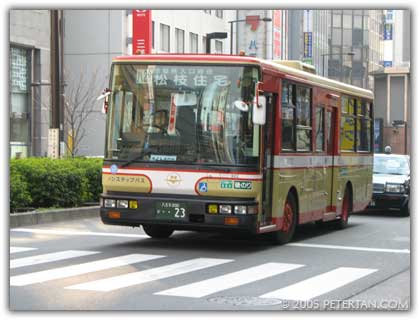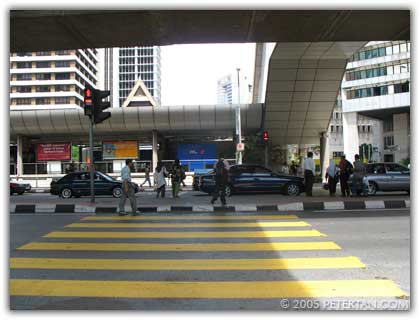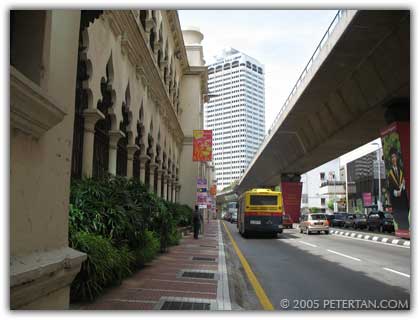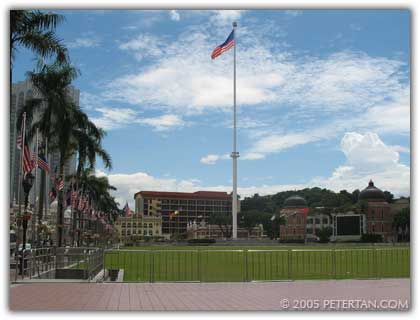During the last accessible toilet debacle, some have rightly pointed out that they do not see disabled people using those toilets or in public places very often. That I have to agree. The reason why people with disabilities, especially wheelchair users, are not often seen in public places can be attributed to one main factor – lack of accessibility.

Non-step bus in Hachioji City.
When I was in Hachioji and Shinjuku, I met many wheelchair users going about in both cities. A majority of them are severely disabled, using electric wheelchairs and accompanied by a Personal Assistant. Yet, they were able to travel with ease. This is because Tokyo is very barrier-free and has an accessible public transport system.

Busy intersection in Hachioji City.
Walkways are fully accessible. The gradient at the end of each walkway is gentle. Road junctions have traffic lights for pedestrians. I have not seen a traffic light with arrows as is very common here in Malaysia. When the light is green, traffic is allowed to turn left or right. If there is a pedestrian crossing the road, they have the right of way. The traffic will stop for the pedestrian. At night, drivers turn down their headlights when we crossed the road.

Station Master of Japan Railway with the portable ramp.
The trains and stations are fully accessible, almost. Wheelchair users with train tickets have to pass through a lane beside the Station Master’s office to inform them of the destination. The Station Master will inform the arrival station and accompany the wheelchair user to the platform. The platform and the train is not level. The Station Master will put on a portable ramp for access into the train.

Getting into a non-step bus on a wheelchair at Shinjuku.
The public buses are fully accessible as far as I can see. They are called non-step buses. There are no steps leading into the buses. The height of the bus is almost level to the walkway and can be elevated or lowered hydraulically. They come with a ramp that can be manually pulled out from under the bus and extended. The three of us managed to squeeze into the bus without much trouble.

Outside the Masjid Jamek STAR LRT Station.
The day after I got back from Tokyo, Wuan and I went for a wheelabout beginning from the Masjid Jamek Star LRT Station to Dataran Merdeka. The roads and walkways were uneven and access to walkways was near impossible because the kerbs were too high. Where there were ramps to the walkways, the gradients were mostly too steep. For a manual wheelchair user, going through these badly thought-out design was like going through an obstacle course.

Pedestrain crossing at Jalan Tun Perak.
There is a pedestrian crossing from the Masjid Jamek Star LRT Station to the Putra LRT Station at Jalan Tun Perak. Again, it was near impossible for a wheelchair user to cross the road. The kerbs were simply too high. Even with Wuan helping me, it was a daunting task to lift my wheelchair up and down the kerbs so many times. Dewan Bandaraya Kuala Lumpur (DBKL) building glared down at us from the distance.

The narrow walkway with no ramp down at the other end.
One of my two main concerns during that wheelabout was going up on a walkway and then discovering that the other end was devoid of a ramp to get off. True enough, at the junction, Wuan, for the umpteenth time, had to lift my wheelchair down the road. We had to be aware of the fast moving traffic speeding by just inches away while doing that. That was part of my second concern – the fear of being knocked down by a vehicle.

Dataran Merdeka.
We finally reached Dataran Merdeka. I have never been there before. The sun was bearing down on us mercilessly. I was getting dizzy. My body was protesting against the extreme change of weather – from freezing cold the day before to the blistering equatorial heat. As I looked at the magnificient flag flapping in the wind, I thought how ironical it was that I felt unsafe in my own country each time I am out. One of these days, I may just get knocked down by a car or bus for using the road instead of the walkways. Do I have a choice anyway?

Were these ramps built with wheelchair users in mind?
Those are the few of many reasons why we do not see wheelchair users out and about. Accessible public transport is practically non-existent. Walkways and roads were constructed with no consideration for wheelchair users. Barrier-free facilities like these do not benefit wheelchair users only. With a rapidly aging population, we have to accept that age, disease and accidents will render this segment of people with mobility problems. They will greatly gain from an accessible environment and public transport, among others. From the looks of it, we still have a long way to go before ours become a barrier-free society for the mobility impaired.

I fully, fully, fully agree with you. There is no way that handicapped can go about here alone. The kerbs are too high, or none at all (sometimes, all you get is a steep, steep step). Where there is one, cars are parked. The pavements are uneven, half rotten, and it is not ease even to walk! I am sometimes wondering about older people already, what about those that are not able to move about?
It is an economic, efficient society, this Malaysia. As much as I like it, I dearly miss places to walk, to slender, clean pathways and easy to cross roads. How I can sympathise with you, Peter!!
Peter:
We are handicapped by an unfriendly environment. If a little more thought was put into building infrastruture that caters to the needs of all walks of society, we definitely will be able to see more physically impaired people coming out. It does not make economic sense to build inaccessible facilities only to renovate it to include accessible features later. Even when such accessibility is incorporated into the design, care must be taken to ensure that they are usable and functional.
that bus thingy, that allows wheelchair to board, as I was saying to you, that photo needs to be sent to the transport ministry. You cannot wait for the Datins lah. You sure they will take a photo like you did here or not?
Peter:
One step at a time. We are planning our moves. 😀
I’m an architectural student in the UK of which most of our practice designs especially those of urban planning have to abide by rules an regulations for accessibility for wheelchair users. It’ll be a long time until Malaysia does that. Even so, it will take a few years to accomplish. It will happen but it won’t be in the next decade i reckon.
Peter:
We have the legislation. What we lack is the enforcement. The local authorities have to be constantly reminded to adhere to these standards which they very often ignore. It is a vicious cycle.
very inspiring. it’s true with what JoMel said, time to rally for it. Emily has a point too, it would take at least a decade! considering now that the public transport is in a total mess (ok, not that total, but definitely more than 50% :p ), i doubt that they can enforce the standards.
p/s: a belated happy V day!
Peter:
There is no accessible public transport for wheelchair users here. Yes, we are looking in ways to convince the government that this is imporant to us.
Hi Peter, Please allow me to rant about the issue of accessibility of the street environment. It is interesting that you did a wheel-about around the Masjid Jamek area, and highlighted the issues of the lack of accessibility, safety and usability of the streets, pavement and crossings.
We did a report on Pedestrian-friendly Kuala Lumpur back then in 1999, and it was also sponsored by JICA. During the Interim Stage, DBKL decided to take out the title below ” Disabled Friendly Study”, hence it was watered down after that, meaning disabled-friendly is not the focus. I wonder what DBKL did with the report. I assume some of the findings were referred to, but since you highlighted the problems, I realised that the same problems are there.
That reminded me of the question that I posed to a DBKL engineer in a seminar. How come the pavement heights are not 6 inches (15cm) maximum but get to be even 8 inches to a foot at times? He said that is because of wanting the monsoon drain grilles to let the water away. He also said that when they lay the roads with tarmac, they need the extra inches so that when they top up, the pavement is still high enough.
Sorry but I think its all a load of bullshit. Firstly, rather than concentrate the monsoon drain grilles to be at a certain spot along the underside of the pavement, say after every 30 ft, why not have the whole pavement grilles at the side, so more holes are available for drainage, and also lower the height of the grilles. Secondly, why not scrape the old tarmac from the road first and then lay the new tarmac rather than do a patch up job layer upon layer, so that a certain height of tarmac is achieved everytime.
The reason why these issues are the basis for unaccessible curbs are simple. It’s a design and maintenance problem, and when they decide to go above 6 inches, the ramped curb if built will not have the correct gradient / slope to be usable.
So the problems that I highlighted here then suggests that it became impossible for them to implement the legislation which by the way never got gazetted at all – I think it was Malaysian Standards (forgot the number) for outside buildings and they replaced it with just a guideline (not detailed enough) with no tooth (not under an Act)… We only got MS 1884 which is for inside buildings.
Also many ministries are involved with different elements of the street environment, so that is one of the reasons for poor coordination and management. Min. of Transport – Highways Act, Pedestrian crossings and lights/warnings; Min. of Entrepeneur – Public Vehicle Licensing that determine bus-stops locations; DBKL (?) – Prime Minister’s Dept. / Fed. Territory Min.; Outside buildings area / LRT stations (?) – Min of Housing and Local Govt.; Min. of Public Works (?) – Pedestrian Bridges, Flyovers(?) ( I am actually assuming these functions to the ministries, need to confirm it though…)
Perhaps we should propose for a Disabled Persons Transport Advisory Committee (DPTAC) like in the UK that is a “statutory body” established under the UK Transport Act 1985.
http://www.dptac.gov.uk
Peter:
Naziaty, you have said everything that needed to be said. Thank you. That was very enlightening.
Sorry, I remember now that it was Malaysian Standards MS 1331 – Disabled Access for Outside of Buildings. The problem was when they did that MS 1331, they “copied” the British version. You see, although Malaysia followed British Administrative Laws, when we expand our townships, we never actually followed through, hence we had designed and built the environment to our own set of standards. What is riduculous is the fact that they cancelled MS 1331 which never got to be gazetted through an Act like the Town and Country Planning Act but instead they got an academic to do a set of guidelines. Guidelines are just a set of administrative document, which is not even a standard. At least standard you can go through SIRIM, and make sure of the quality.
Peter:
I must get a copy of that MS 1331:2003 – Code of Practice for Access for Disabled Persons Outside Buildings. Very interesting points that you brought up. Thank you again.
I was at the pedestrian crossing at Masjid Jamek sometime back. As I was crossing, a blind man was trying to cross from the opposite side. I helped him to cross. When you have sight, it’s easy to just walk up to a platform and climb it. But to a blind person, they have to constantly feel it. As we reached the end of the crossing, I told him there was a platform in front of him. The thing was I told him a bit too early, and he was feeling for the platform with his feet in mid air whereas the platform was still a bit far from where we were standing. Felt bad about that. I made sure he was on the platform, before I went back on my way.
Peter:
BawangMerah, that was very nice of you. In Tokyo, the height of the kerb for ramps is no more than 2cm. This is to indicate the end of the walkway to the blind. If the kerbs were made any higher, it would pose some difficuly for wheelchair users. Therefore this a good compromise for both.
I’d like to see this country getting to the point where people with disabilities are no longer limited by lack of accessibility. When I lived in Australia, I used to go to the city and stroll around, shopping and people-watching. At least three out of 10 people I saw were PWD and there they were, shopping and people-watching with ease and comfort. The system is rigged such that all groups had access to public transport and wheelchair-friendly amenities. Now that is what I call a developed country.